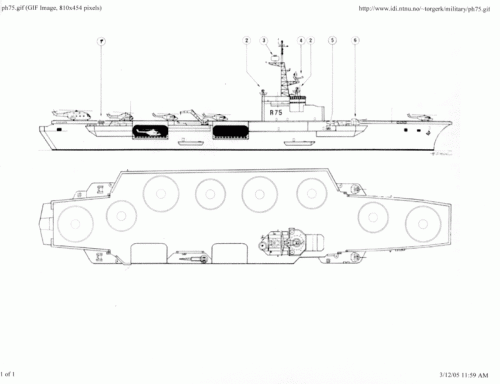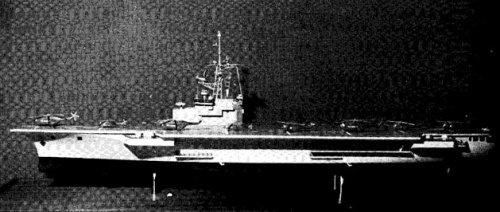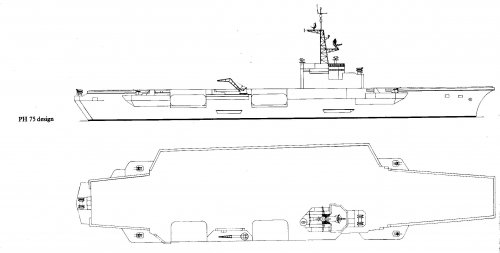PH 75/PA 75 was a military development program in France aimed at designing a nuclear-powered amphibious assault ship during the 1970s for the French Navy (Marine Nationale). Two ships were planned. Design work was never completed by the time the project was canceled.
Source: ALL THE WORLD’S FIGHTING SHIPS – PART 1: THE WESTERN POWERS
Authors: John Jordan ( Belgium, France, Netherlands )
Line Drawings: Przemyslaw Budzbon – with Mark Twardowski
Publisher: CONWAY MARITIME PRESS
Date: 1983 – © 1983 Conway Maritime Press Ltd
In 1970, with Arromanches fast approaching the end of her active life, studies were undertaken to provide for a replacement. A number of possible designs were produced, all of which shared the 55,000shp steam plant of the F 67 frigates, a through deck for helicopters, and a uniform armament of four 100mm mountings.
The first three versions displaced 20,000-22,000t, had a waterline length between 187m and 200m and a beam of 28m, with a maximum speed of 27kts. The first two versions incorporated a docking well aft, 40-50m long and 14m wide. The docking well of the first variant could accommodate four LCMs (26t), while that of the second variant, which was longer and higher, could accommodate two LCMs and two CTMs (56t). (The LCM has a cargo capacity of 30t, and the CTM of 90t, and both can carry a light or medium tank).
The flight deck configuration of the first variant was clearly influenced by the US Navy's Iwo Jima class; the deck itself was rounded off at its forward edge, and side lifts were staggered to port and starboard. In the second variant the flight deck had a broad centre section not unlike that of the US Navy's CVAs, with lifts on either side of the island to starboard incorporated into the overhang. A similar arrangement was adopted in the third variant, which dispensed altogether with the docking well.
These first three variants all had a hangar of about 90m length with a capacity of 8 Super Frelons and 18 Lynx. There was accommodation for 600 men and their equipment, together with light vehicles.
The fourth variant was a smaller vessel, 170m x 25m, with a displacement of 15,000t, and a consequent increase in speed to 28.5kts. Flight configuration was similar to that of Clemenceau, with a centreline lift forward and a side lift to starboard, aft the island. Helicopter capacity was reduced to seven Super Frelons and 16 Lynx, and troop capacity to 450.
In the event none of these designs was proceeded with, but they served as the basis of an even more ambitious project, PH 75. Similar in conception, size and configuration to the third variant of the 1970 designs, PH 75 was to have nuclear propulsion to give her unlimited range for distant intervention. Like Jeanne d'Arc, she would be able to assume the ASW role as an alternative to that of amphibious assault, and was also designed for disaster relief. She was, therefore, given extensive hospital facilities consisting of three main wards, an X-Ray ward, an intensive care ward, an infectious diseases ward, two dental surgeries and a laboratory.
In the intervention role she would carry a special landing force of units from the Forces Terrestres d'Intervenntion (FTI) and their supporting air units (CAFI), plus a Helicopter Movement Command Centre. 1000 troops could be accommodated in designated quarters, with a further 500 in supplementary spaces in the hangar.
The ship would embark Super Frelon and Lynx helicopters in the ASW role, or Puma helicopters for the assault mission. Hangar dimensions were 84m x 21m x 6.5m and there were two side lifts each with a capacity of 15t. There was one fixed and one mobile crane, and extensive helicopter support facilities including workshops, munitions-handling rooms, magazines, and fuel tanks for 1000m3 of aviation fuel.
PH 75 was to be fitted as a command ship, with an action information centre, a communications centre, an ASW centre and an amphibious operations centre. She would carry 1250t of FFO for refuelling escorting warships. As with other French nuclear-powered vessels there were emergency diesel propulsion units capable of powering the ship for 3000nm at 18kts.
PH 75 was originally intended to complete in 1981, but financial problems delayed construction, and the design has been successively re-designated PA 75, PA 78, PA 82, and now PA 88. The change in classification from 'PH' (Porte-Helicopteres) to 'PA' (Porte-Aeronefs) indicates an intention to provide for the embarkation of VTOL aircraft. It now seems likely, however, that if this ship is built at all it will be as a replacement for Jeanne d'Arc, and that she will not be completed before 1990.
Specifications
Displacement: 16,400t standard 18,400t full load
Dimensions: 682ft oa x 87ft wI, 157ft fd x 21ft
208.0m x 26.4m, 46.0m x 6.5m
Machinery: 2-shaft nuclear: 1 CAS-230 reactor, 2 turbo-reduction-condenser groups
65,000shp = 28kts; 2 AGO standby diesels
Armament: 2 Crotale SAM (2x8), 2-100mm (2xl), 2 Sagaie, 10-25 helicopters
Sensors: Radar DRBV-26, DRBV-51, DRBC-32; sonar DUBA-25
Complement: 890 (+ 1000 troops)
Source: ALL THE WORLD’S FIGHTING SHIPS – PART 1: THE WESTERN POWERS
Authors: John Jordan ( Belgium, France, Netherlands )
Line Drawings: Przemyslaw Budzbon – with Mark Twardowski
Publisher: CONWAY MARITIME PRESS
Date: 1983 – © 1983 Conway Maritime Press Ltd







